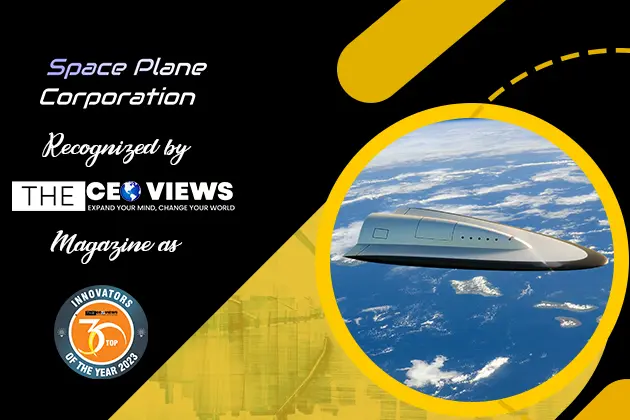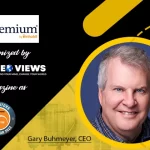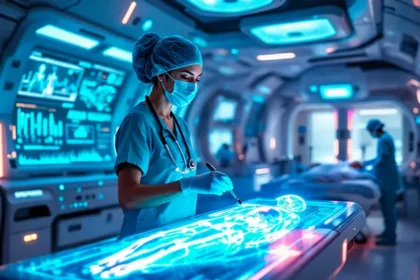The major technological innovations are reshaping various facets of the aerospace industry. As we take a deep dive into the niche, we can see numerous opportunities that are revolutionizing space exploration. Space Plane Corporation, a multi-national non–profit organization recognizes the potential of these evolving opportunities. In a recent interview with Axel Rohde, CEO of Space Plane Corporation, we uncover the remarkable journey of the organization, its strength and strategies and the unique value proposition that makes it to the list of “Innovators of the Year 2023″.
The CEO Views: Space Plane Corporation is an open–source design project for a single–stage–to–orbit (SSTO) horizontal take–off and landing vehicle. Being fully reusable and able to take off and land on most runways. How did it all begin? What was your mission at the outset?
Axel Rohde: We started out as a small informal working group in early 2021, exploring the feasibility of a single–stage–to–orbit launch vehicle, which has been considered the ‘holy grail‘ in aerospace engineering since 1977. After researching the literature and evaluating different propulsion systems, we arrived at our current conceptual design.
The CEO Views: Space Plane Corporation has been recognized as “Innovators of the year.” How was your journey so far?
Axel Rohde: We formed a Florida non–profit corporation in 2022 and have been busy with our design and analysis, getting our website up and running, and working towards our tax–exempt status, which we plan to obtain next year. All our directors are part–time volunteers, so our progress has not been as fast paced as we would wish.
The CEO Views: Space Plane is much safer than conventional rockets. Can you explicate this statement to us in brief?
Axel Rohde: Any misfire during a lift–off in a conventional rocket launch can be catastrophic to the mission, resulting in loss of payload and occupants. Aborting a lift–off, once the rocket engines have started, typically has to be done within one second. The thrust–to–weight ratio of a rocket needs to be greater than one just to get off the ground. During the horizontal take–off of Space Plane, the thrust to weight ratio is less than one, and there are more than ten seconds time to shut down the engine, in case it produces insufficient thrust. That is a huge decision window compared to vertical take–off. Once a rocket has been released from its launch pad, there is no safe roll–out like with Space Plane on a runway.
The CEO Views: Space Plane Corporation claims that it will make orbital space tourism an experience as smooth as a commercial airline flight. What are your innovative ideas towards making it a reality?
Axel Rohde: Space Plane is designed for dual use, being able to deliver commercial cargo to low Earth orbit while accommodating up to ten passengers on each flight. The climb and descent angles of lifting ascent and re–entry will result in minimal g–loads (g < 2). Reclining seats will continuously adjust themselves to minimize the acceleration feel while keeping the window within view. A typical mission will last 24 hours. Passengers will enjoy ‘space smoothies‘ in pouches based on their dietary and hydration needs. We are also working on a clean and easy–to–use space toilet.
The CEO Views: How has your firm been structured? How does it help in the growth of the firm?
Axel Rohde: Space Plane is a non–profit organization which relies on government and industry funding and volunteer participation from researchers whose interests align with our mission. We are incorporated in Florida but will soon start another non–profit corporation in the EU to broaden our exposure to funding and expertise.
Space Plane is designed for dual use, being able to deliver commercial cargo to low Earth orbit while accommodating up to ten passengers on each flight.
The CEO Views: After a year of researching different engine configurations for Space Plane, the directors decide on a rocket–based combined cycle (RBCC). What are the special innovative features it possesses?
Axel Rohde: The RBCC engine has very few moving parts, which makes it lightweight, yet it covers the entire range of flight Mach numbers from take-off to orbit insertion. It is a hybrid engine, working as a ramjet, scramjet, and ducted rocket, with all three systems sharing the same flow path.
The CEO Views: Can you brief us about how Space Plane has been well and innovatively equipped, making it more convenient than conventional rockets?
Axel Rohde: Conventional rockets are multi–stage and have to be reassembled after every launch, unlike a single–stage vehicle that only needs to be refueled. This yields a quick turnaround time and reduces cost. Space Plane can take off from any runway built for large passenger aircraft.
The CEO Views: Can you brief us a little about your design overview? How innovative is your firm with its design for the model?
Axel Rohde: To make our vehicle single–stage–to–orbit, SSTO, all the propellant has to fit inside its airframe. We came up with a rounded delta–shaped wing with sufficient thickness to fit all the tanks. The wing design looks similar to a surfboard and is well suited for riding the supersonic and hypersonic compression waves while providing ample lift at take–off. Our current design has been run through rigorous virtual wind tunnel (CFD) testing with speeds ranging from Mach 0.3 to 25.
The CEO Views: What technology does your firm implement for smoothly carrying out its work process?
Axel Rohde: We use Telegram Messenger for all our internal communications, including video meetings, and we share a terabyte cloud storage drive for all our files. All the design work is available on our website, accessible to everyone. Since we are an open–source project, this is an organizational requirement.
The CEO Views: According to you, what are the upcoming market trends in your industry?
Axel Rohde: The largest part of the global space economy is data–driven applications. Satellites provide and transport data. They are indispensable for weather forecasts, global positioning, and communication. Space tourism is still a tiny fraction of this market but will continue to grow as access to space becomes less costly.
The CEO Views: What challenges did your firm come across throughout its journey so far?
Axel Rohde: Our five directors all work without compensation and most of us have jobs outside of our organization. Until we can secure significant funding, we will only outsource a small fraction of our work to third parties. Our budget has so far been limited to private donations.
The CEO Views: Any kind of special advice you would like to give your peers in the industry for attaining goals innovatively?
Axel Rohde: I think you need to have a passion for what you do and be able to think outside the box. Do not let naysayers deter you, but be open to constructive criticism. Only work with the best design and simulation tools and a team who knows how to use them effectively. Everything else will fall into place.










